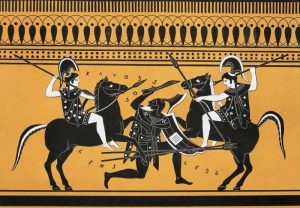Are the skilled female warriors who once conquered a vast land in the Black Sea in Greek mythology, or are they just fictional characters in Greek mythology?
Historians today think that the Amazons who first appeared in Homer’s poetry in the 8th century BC were just imaginary characters. But in the 1990s, archaeologists began to find ancient female skeletons buried in warrior tombs in this region.
Researcher Adrienne Mayor at Stanford University, USA, said that some of the skeletons showed signs of battle injuries, such as arrowheads still embedded in the bones, or were buried with weapons similar to those found in the body. used by the Amazon warriors as depicted in ancient Greek art.

An illustration of Amazons in combat, from the Collection des vases grecs de le Comte de M Lamberg, volume II, Table 17, Paris, 1813 to 1824, by Alexandre de Laborde.
Thanks to archaeological finds, we now know that the Amazon warrior legends, which were considered fictional, actually contain accurate details about nomadic women in the savannah, who were once the archetypes of the legendary Amazons.
These nomadic warriors were part of the ancient Scythian tribes, masters of horsemanship and archery. They lived across the Eurasian steppes, stretching from the Black Sea to China, between 700 BC and 500 AD.
The Scythians were a strong, tough people. They were very good at drinking pure wine, unlike the Greeks who often mixed wine with water, fermenting horse milk and taking hemp extract as a nutritious food. Scynthian mummies preserved in permafrost show that they have many animal tattoos on their bodies.
Scynthian social organizations were not just women, as depicted in Greek mythology, but were simply groups of women who lived like men. Essentially, some women, but not all, were involved in hunting and fighting alongside men.
In the situation of living and fighting on the vast and harsh grasslands, cooperation and mutual protection are extremely necessary, regardless of the age and gender of the people in the same group. Skeletons of female warriors aged 10 to 45 years old have been found in Scynthian burials.
So far, archaeologists have identified more than 300 female warriors buried with war horses and weapons, and each year they uncover new remains.
The Scynthians weren’t the only people whose women hunted and fought, and the Greeks weren’t the only people to tell stories of Amazon warriors and women who lived like Amazons.
In the stories told from ancient times in Rome, in Egypt, in North America, in Arabia, in Mesopotamia, in Persia, in Central Asia, in India, and in China, there are all very interesting stories, some of them stories. fictitious and some based on real events, about women who live as Amazon warriors. And women in combat are found all over the world, from Vietnam to the lands of the Vikings, both in Africa and the Americas.
The name “Amazon River” in South America is also related to one of the stories of the ancient warriors. According to the open dictionary Encyclopedia Britannica, a Spanish soldier named Francisco de Orellana, believed to be the first European to explore the Amazon region in 1541, named the river so after he was captured by female warriors. attackers, whom he likened to the legendary Amazons we hear about the Scynthians today.

